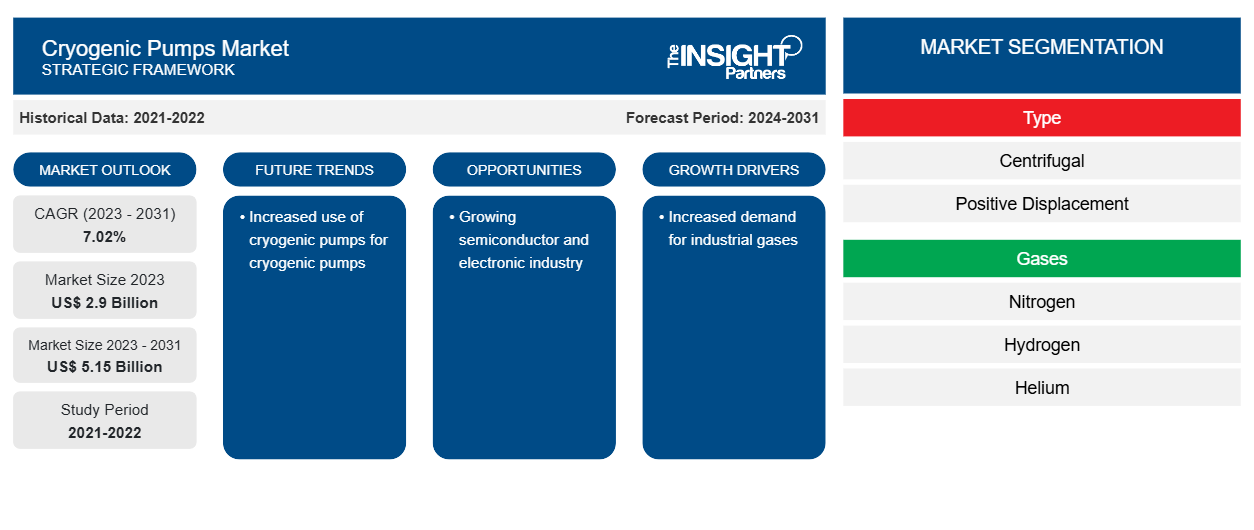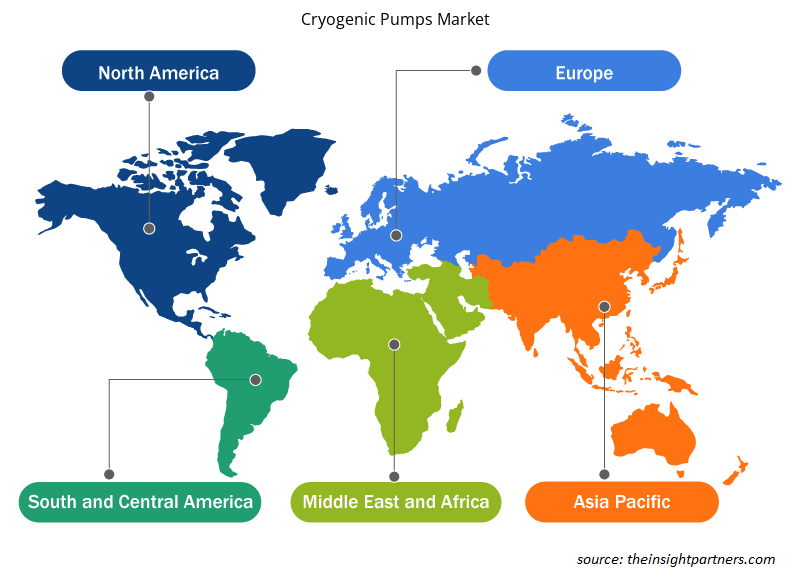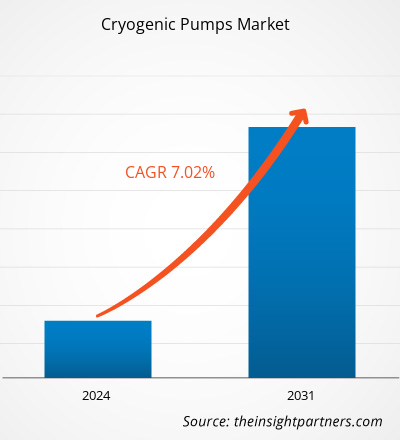低温泵市场规模预计将从2024年的24.2913亿美元增至2031年的35.4358亿美元。预计2025年至2031年期间,该市场的复合年增长率将达到5.6%。医疗保健领域投资的不断增加可能会在未来几年为市场带来新的趋势。
低温泵市场分析
低温泵或低温泵是用于输送和加压液化气体的低温设备。它是一种用于输送氮气、氧气、液化石油气和氩气等低温气体的真空泵。低温泵能够高效冷却,非常适合需要快速且持续冷却的应用。此外,这些泵的设计使其能够高精度运行,即使在极端条件下也能确保最佳性能。此外,低温泵内置安全装置,防泄漏,确保其在输送制冷剂时高度安全。近年来,低温泵制造商集成了自动化控制系统,进一步增强了这些泵的监控和精确操作。
低温泵市场概况
由于工业化进程,尤其是在新兴经济体,低温泵市场预计将在未来几年经历显著增长。随着液化气需求的不断增长,低温泵市场也越来越受到关注。对可持续清洁燃料的需求不断增长,以取代排放碳的化石燃料。因此,对液化天然气的需求增加,最终推动了对气体处理系统的需求。由于中国、印度、日本、韩国和印度尼西亚等国的工业化,亚太地区是最大的液化天然气消费地区之一。根据壳牌公司发布的数据,预计到 2040 年,亚太地区的经济增长将推动液化天然气需求增长 60%。预计到 2030 年,液化天然气新增供应量将超过 1.7 亿吨,以满足不断增长的需求,尤其是来自亚洲国家的需求。中国和印度是亚太地区两个主要国家,它们正在采取显著举措来增加其液化天然气进口能力。液化天然气需求的不断增长以及工业投资的不断增长等是推动市场增长的主要驱动力。
您可以免费定制任何报告,包括本报告的部分内容、国家级分析、Excel 数据包,以及为初创企业和大学提供优惠和折扣
低温泵市场:战略洞察

-
获取此报告的顶级关键市场趋势。此免费样品将包括数据分析,从市场趋势到估计和预测。
低温泵市场驱动因素和机遇
液化天然气需求不断增长
随着碳排放和污染问题日益受到关注,对清洁能源燃料和可再生能源的需求正以前所未有的速度增长。液化天然气(LNG) 是一种用途广泛的清洁能源燃料。这种燃料可用于供暖和发电。由于液化天然气效率高且碳排放量低,非常适合发电和工业应用,其应用范围已显著扩大。低温泵在液化天然气运输中发挥着重要作用。为了有效运输,天然气必须保持在极低的温度下。这些泵采用特殊设计,包括特殊材料、隔热和密封,以确保在极端温度下的安全性和可靠性。因此,低温泵在液化天然气行业的应用率很高。
根据壳牌公司 2024 年 2 月发布的数据,全球液化天然气贸易量从 2022 年的 3.97 亿吨增加到 2023 年的 4.04 亿吨。此外,根据能源部 2024 年发布的数据,2021 年液化天然气需求量为 1000 亿立方米 (bcm),而 2022 年需求量达到约 1750 亿立方米 (bcm)。亚太地区占全球液化天然气需求的大部分。根据壳牌公司 2025 年发布的数据,2024 年液化天然气需求增强;中国是该地区值得注意的国家之一。2024 年,中国进口了 7900 万吨液化天然气。另一方面,印度的进口量在 2024 年达到峰值,以满足不断增长的电力需求。印度2024年的液化天然气需求量将达到2700万吨,较2023年增长20%。马来西亚和印度尼西亚已成为亚太地区重要的液化天然气出口国。根据国际天然气联盟2023年发布的数据,印度尼西亚2023年的液化天然气出口量达到1560万吨,马来西亚出口量为260万吨。然而,这两个国家的出口能力约为3000万吨。因此,全球液化天然气需求的激增和贸易的扩张,加速了对高效安全运输所需的低温泵的需求。
能源领域应用日益增多
随着工业化和城镇化的发展,全球能源需求快速增长。根据国际能源署 2025 年发布的数据,2024 年全球能源需求较 2023 年增长 2.2%,高于过去十年的平均增长率。此外,预计 2024 年至 2030 年期间可再生能源发电装机容量将增加 5,500 吉瓦 (GW),是 2017 年至 2023 年增幅的三倍。这表明能源需求正在快速增长。因此,为了满足日益增长的需求,世界各地的政府和能源公司正在开展各种研发活动,以开发创新的能源生产和储存系统。低温储能就是其中之一。低温储能利用极低的温度来释放和储存能量。这为大型能源系统项目提供了一种高效的解决方案。在低温储能中,气体被冷却,转化为液态,然后在极低的温度下储存。低温泵在这些系统中发挥着重要作用,能够有效、高效地处理低温剂(液化气体)。
鉴于能源需求和储能系统需求的增长,各国政府正在投资开发和安装低温储能系统。例如,2024年10月,苏格兰政府在该国启动了全球最大的液态空气储能系统(LDES)项目。2024年11月,韩国东国大学的研究人员成功设计了一套独立的液态空气储能(LAES)系统,显著提高了能源效率和经济性能。此外,2024年10月,英国政府宣布在英国曼彻斯特启动一项耗资3亿美元的低温储能系统项目。由于能源需求的增长,对低温储能系统的投资不断增加,预计将在预测期内为低温泵市场创造丰厚的商机。
低温泵市场报告细分分析
有助于得出低温泵市场分析的关键部分是类型、设计类型、低温剂和行业垂直。
- 就类型而言,市场分为离心式和正排量式。2024年,离心式泵市场将占据主导地位。
- 根据设计类型,市场分为潜水型和非潜水型。潜水型在2024年占据市场主导地位。
- 根据制冷剂,市场分为氮气、氩气、氧气、液化天然气、氢气、氦气和其他制冷剂。液化天然气将在2024年占据市场主导地位。
- 根据行业垂直划分,市场分为电子和半导体、医疗保健和制药、能源和电力、冶金、航空航天、化工等。2024年,能源和电力领域占据市场主导地位。
低温泵市场份额地域分析
低温泵市场分为五大区域:北美、欧洲、亚太地区 (APAC)、中东和非洲 (MEA) 以及南美和中美 (SAM)。2024 年,亚太地区占据市场主导地位,其次是北美和欧洲。
亚太地区的低温泵市场主要分布在中国、日本、韩国、澳大利亚和印度。半导体材料市场规模达640亿美元,包括供应链前端(400亿美元)和后端(ATP)(240亿美元)使用的化学品和材料。在前端材料领域,硅晶圆和光刻胶的市场规模约为195亿美元,约占整个市场的一半。此外,气体、湿化学品、CMP研磨液和溅射靶材等其他重要子类别在各种制造工艺中也发挥着关键作用。
后端 ATP 市场价值 950 亿美元,主要集中在东北亚,大部分产能位于韩国、中国大陆和台湾,约占全球 ATP 产能的 60%。自 2023 年以来,在宣布的 36 个 ATP 设施中,预计将有 25 个建在中国大陆和台湾,这得益于较低的建设成本和熟练劳动力成本。台湾和韩国在半导体制造业中都举足轻重,通过台积电的尖端代工业务,台湾占据了 70% 以上的先进节点芯片制造(<10 纳米)。韩国也对其半导体行业进行了大量投资,三星和 SK 海力士等公司分别引领全球 NAND 闪存和 DRAM 芯片市场,这对低温泵市场产生了积极影响。
低温泵市场区域洞察
Insight Partners 的分析师已详尽阐述了预测期内影响低温泵市场的区域趋势和因素。本节还讨论了北美、欧洲、亚太地区、中东和非洲以及南美和中美洲的低温泵市场细分和地域分布。

- 获取低温泵市场的区域具体数据
低温泵市场报告范围
| 报告属性 | 细节 |
|---|---|
| 2024年的市场规模 | 24.2913亿美元 |
| 2031年的市场规模 | 35.4358亿美元 |
| 全球复合年增长率(2025-2031) | 5.6% |
| 史料 | 2021-2023 |
| 预测期 | 2025-2031 |
| 涵盖的领域 |
按类型
|
| 覆盖地区和国家 |
北美
|
| 市场领导者和主要公司简介 |
|
低温泵市场参与者密度:了解其对业务动态的影响
低温泵市场正在快速增长,这得益于终端用户需求的不断增长,而这些需求的驱动因素包括消费者偏好的演变、技术进步以及对产品优势的认知度的提升。随着需求的增长,企业正在扩展产品线,不断创新以满足消费者需求,并抓住新兴趋势,从而进一步推动市场增长。
市场参与者密度是指特定市场或行业内企业或公司的分布情况。它表明特定市场空间内竞争对手(市场参与者)的数量相对于其规模或总市值而言。
在低温泵市场运营的主要公司有:
- SHI低温集团
- 法孚特种部队
- Cryostar SAS
- 荏原埃利奥特能源
- 低温机械公司
- 日机装株式会社
免责声明:以上列出的公司没有按照任何特定顺序排列。

- 获取低温泵市场主要参与者概览
低温泵市场新闻和最新发展
低温泵市场的评估是通过收集一手和二手研究的定性和定量数据进行的,这些数据包括重要的公司出版物、协会数据和数据库。低温泵市场的一些关键发展如下:
- 苏尔寿近期在墨西哥城庆祝其全新测试和装配中心正式投入使用,该中心与其现有的泵制造工厂并建。此次扩建将提升苏尔寿墨西哥泵工厂的大型泵系列产能,以满足美洲地区日益增长的基础设施需求。(来源:苏尔寿,新闻稿,2025年3月)
- Vanzetti Engineering 正在扩展其产品组合,推出全新系列潜水泵——ESK-IMO 伸缩式系列,流量范围从 70 立方米/小时到 500 立方米/小时,扬程最高可达 240 米。(来源:Vanzetti Engineering,新闻稿,2024 年 3 月)
低温泵市场报告覆盖范围和交付成果
“低温泵市场规模和预测(2025-2031)”对以下领域进行了详细的市场分析:
- 低温泵市场规模以及涵盖范围内所有主要细分市场的全球、区域和国家层面的预测
- 低温泵市场趋势以及市场动态,如驱动因素、限制因素和关键机遇
- 详细的 PEST 和 SWOT 分析
- 低温泵市场分析涵盖主要市场趋势、全球和区域框架、主要参与者、法规和最新市场发展
- 行业格局和竞争分析,包括市场集中度、热图分析、知名参与者以及低温泵市场的最新发展
- 详细的公司简介
- 历史分析(2 年)、基准年、预测(7 年)及复合年增长率
- PEST和SWOT分析
- 市场规模、价值/数量 - 全球、区域、国家
- 行业和竞争格局
- Excel 数据集
近期报告
客户评价
购买理由
- 明智的决策
- 了解市场动态
- 竞争分析
- 客户洞察
- 市场预测
- 风险规避
- 战略规划
- 投资论证
- 识别新兴市场
- 优化营销策略
- 提升运营效率
- 顺应监管趋势






















 获取免费样品 - 低温泵市场
获取免费样品 - 低温泵市场